By Kata Dismukes, Alessia Faverio, Lisa Malick, April O’Gorman, and Salli O’Donnell. Edited by Lisa Malick, original art by Sophie Dismukes.
Go to a surfski race on the East Coast of the United States and ask the paddlers how they got involved in surfski. Chances are, you will get some of the most diverse answers ever!
Even better, ask the women at these races how they got involved in surfski!
Since surfski in America, especially the East Coast, especially for women, is not a mainstream sport, we find ourselves coming from a wide array of backgrounds. This creates a rich tapestry of diversity in our sport.
Some of the top surfski paddlers on the East Coast are actually not surfskiers from the start: they were once swimmers, runners, surfers, and vacation kayakers. Hey! These sports are pretty common! It is our intent that you, the reader, the awesome-kick-butt-in-your-sport-athlete can see yourself in these feature profiles. If you do, we hope to welcome you to your new sport: surfski!
April O’Gorman, USLA Surf Ironwoman
April was the 2018 USLA Surf Ironwoman National Champion. She placed 3rd at USLA Nationals in (Spec) Surf Ski, and was the youngest on the USLA open team. April is now paddling surfski, and placed 2nd in the East Coast Surfski Championship.
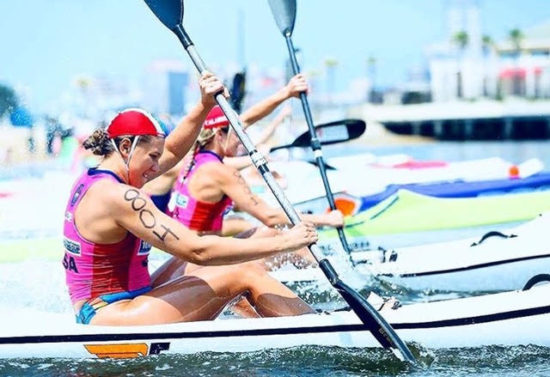
My ideal conditions definitely involve some waves and wind. I like the changing elements and being able to use it to my advantage. I love to paddle in the early morning or sunset so it is a little cooler outside. I paddle the most in Daytona Beach but it definitely isn’t my favorite place to. If I could paddle anywhere in the world it would be in Australia.
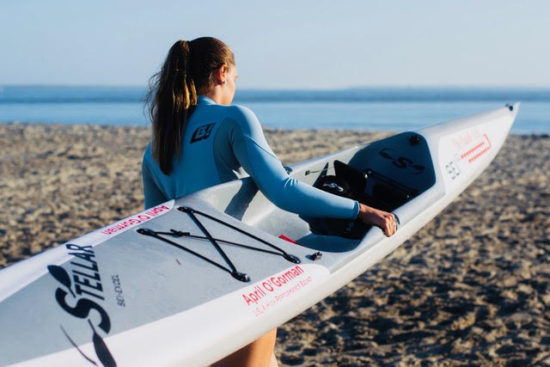
I started to paddle surfski because I had already been swimming as a competitive swimmer for nine years and there wasn’t very much else I could learn about the sport and especially being a distance swimmer, it really started to get monotonous. Surfski was a new challenge for me and I felt like I was learning every time I trained. The conditions are always different in the ocean so I never get bored.
I competed on my first USLA National Team at Worlds in 2016 in the Netherlands as a swimmer. There were so many other events that I wanted to do but couldn’t because I was just a swimmer. That is when I made the decision that I would never go on another national team as just “the swimmer,” and began to learn how to paddle. I completely fell in love with it and haven’t been a “swimmer” on the national team since.
The most exciting part of swimming for me was always racing. Growing up as a swimmer somewhere along the way I lost that racing fire and really didn’t even pay attention to anyone else in my races because even if you won that meet you may gain 10 seconds on your personal best time. I began racing the clock rather than the people around me and I think that is when I began to lose that racing fire. Surf lifesaving and surfski introduced me to a new kind of racing and I believe made me a better swimmer. I fell in love with surf lifesaving because it brought me back to that pure joy in racing. Just you and the person on the line next to you. No $500 tech suits, touch pads, or one one hundredth of a second. Just everything you have against the person next to you. I noticed a difference in the pool immediately. I had that racing fire back and was more concerned about racing the people in the lane next to me then what the clock said. Because of this new competitive drive I gained from surf lifesaving, I was able to push myself harder then ever before in the pool.

My favorite thing about paddling is that it is always different every time. A pool is a pool no matter where in the world you are. Every body of water in nature whether it is a river or an ocean is going to be different and it is changing constantly. To be a good competitor in surf lifesaving and surfski the most important thing is to understand and know the water you are racing. Reading the currents, the wind, the waves. So I am always learning something every time I am training or competing. Either about the skill of actually paddling, or about the water I am paddling in.
Lisa Hertz Malick, Prone, Surfski, Marathon Swimmer, Surfer
Lisa Hertz Malick has won and set course records for several East Coast ocean races in surfski, prone paddling, and marathon swimming. In 2019, weeks after competing against a top men’s field at the 2019 Carolina Cup ocean and intercostal race on surfski, she won the 22.5 mile ocean/bay prone Dean Randazzo race on prone for the third year and has maintained the course record.
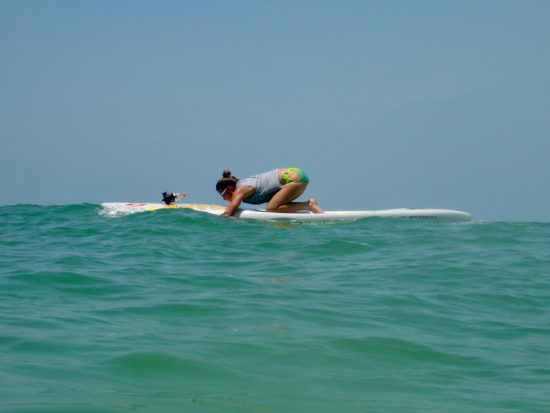
I absolutely love to paddle in the open ocean. Most of my paddles are a few miles out into the ocean and a few miles back, on repeat until I am up to the distance I want for the day. I like to go out in the ocean- whether I am swimming, surfing, or paddling- and be far enough out that I can scan the entire horizon, untouched by modern humans. I like to imagine that I have managed to travel in time. When my ocean view looks exactly as it might have hundreds or thousands of years ago, with prehistoric sea turtles swimming in crystal water, then who is to say I haven’t? It is also humbling to turn around and look at the skyline of the beach towns or cities.
I love waves, especially big waves. The Atlantic Ocean does not produce the biggest waves very consistently, but during the right parts of the year or at just the right places, we can find some good spots. Wrightsville Beach’s inlets can create some amazing conditions for the east coast, and I simultaneously had the time of my life while being scared stiff riding some 6-8’ swells this spring. I was used to that size on a surfboard, but this was completely different on a 16.5” wide, 20’ long ski! I was so stoked that I favored the bigger sets coming out of the inlet, completely forgetting the idea to create a good line. I just wanted the big waves. I want more of them now, so I guess I need to find a way to fund a trip to the Mound, a place where there are giant waves in South Africa. While I’m there I’d like to hop on Millers Run for some downwinds, too!
Paddling was a slippery slope from my main sport of swimming. I’ve swum competitively since I was eight years old. I swam in college, and then I did marathon swimming after graduating. After a few years of marathon swims, the thousand dollar certification fees were no longer feasible and I began prone paddling. My husband took up surfski after seeing them in South Africa when he was there for a marathon swim. I started paddling surfski as well, mostly for winter cross training and to not be left behind on the slower prone board! Eventually I realized I liked surfski just as much!
Prone paddling barely qualifies as a “double bladed sport.” It isn’t a single bladed sport, unless you are unfortunate enough to come across a hungry alligator while paddling in the Wekiva River. However, the catch and muscle groups are very similar in swimming, prone, and ski. I love how I can transition from between these three sports fairly seamlessly. This June, I trained for a 22.5-mile prone race nearly exclusively on ski, and had one of my best paddles yet. I like surfski versus prone paddling because of the speed. Sometimes, it is just really fun to move fast! I also usually have more people to race with when I paddle ski, although this isn’t always the case. I can go into more bodies of water on surfski, like alligator-infected Florida backwater where the rugged Florida guys like to race.
However, prone paddling is exciting because you feel in tune with the water in a way that just does not happen with surfski. Prone is paddling at is most basic elements. You touch the water with each stroke, feel the spray in your face, and experience connectivity unlike any other. Surfing and swimming bring a similar feeling of being one with the water.
Regardless of what I am paddling, I love paddling because it connects me with nature, especially the ocean! It has also brought me closer to a wonderful group of people: the most kind-hearted and enduring people you could ever imagine.
Kata Dismukes, K1 and Surfski
Kata Dismukes was born in Hungary, where sprint paddling is the national sport. She began paddling when she was 9 years old, competing in Sprint K1 Junior races until moving to the USA in 1998. Her childhood dream and training focused on going to the Olympics for sprint events. As a youth K1 paddler, Kata competed in Hungarian Regionals in K1, K2, and K4.
Since transitioning to surfski paddling and longer distance races, Kata remained a formidable opponent. She won the 31-mile Chattajack race five times and is the current women’s course record holder (2015) and Chattajack sprint record holder (2017). She also has the women’s sprint record for the 3 mile OICK (Outdoors Inc. Canoe and Kayak) race.
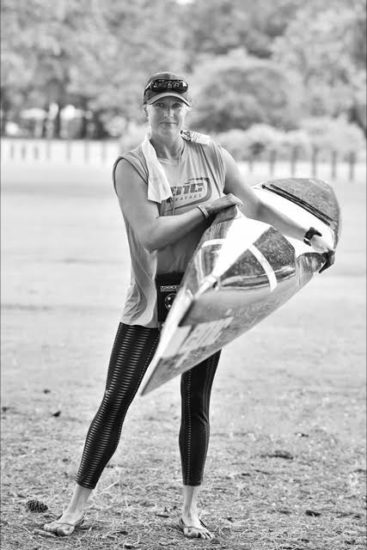
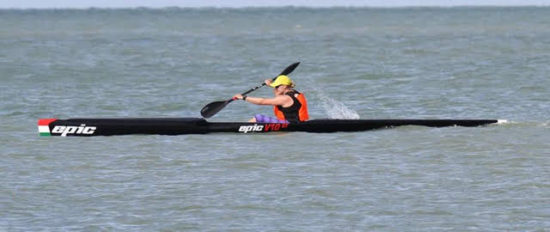
I was 9 when I sat in a kayak for the first time. I have asthma and my pediatrician thought it would be great to get into a sport that would strengthen my lungs. I lived on a lake about 10 minutes from the local kayak club. I gave it a try and never looked back. K1 paddling is our “national” sport and pride. Coming from Hungary I never heard of a surfski until I moved here to the US. One year our city was hosting a local paddling race on the mighty Mississippi River. At that time I only had my K1. Pretty quickly I realized a K1 stood no chance on a wild river like the Mississippi River. Greg Barton from Epic was at this event and he generously offered me one of his surfski and the rest is history. As of today, I still paddle both boats: my surfski and the K1. They are fun in a different ways but both will provide me a great workout. Surfski is a little more forgiving when it comes to stroke style. K1 is definitely not as forgiving. While I will never give up my K1 I do compete most of my races in my surfski.
My ideal condition is flat, flatter, and more flat. I love beautiful mirror flat water. Coming from the sprint K1 background, mirror flat water still has a special place in my heart. It makes the boat glide beautifully. I prefer paddling on lakes or intercostal waterways. Currently, I paddle on our local lake. There are many contenders for my bucket list paddling places but two are on the top of the list. I hope one day I will have the chance to paddle at any of these beautiful places, Maldives or in my home country, on Lake Balaton.
Since the K1 is a shorter boat, it moves different on the water. You sit closer to the water surface and that makes it feel like you are part of the water. Sitting in a surfski after a K1 can feel like you are paddling a submarine. However, one of the nice things about surfski is that you never have to worry about sinking it. Well, you would have to try very, very hard. Since a K1 doesn’t have a bailer, once the water goes in it will stay in until you have a chance to pour it out. On the upside, it will give you a heck of a resistant workout. There is quite of bit of splashing during a race, which makes a surfski a much suitable choice.
Paddling gives me structure mentally and physically. I love being out on the water. I love the way I feel after a good training session. I love the calm mind I get from paddling. And of course, I love our great paddling community. There are a lot of wonderful people in this sport. Life long friends. We all go through rough phases, hit barriers that feel impossible to break through but our community always there to or lift you up and to make you feel better.
Alessia Faverio
Alessia Faverio: Wildwater Paddling
Alessia Faverio is a member of the US Wildwater Team. Alessia has been on the Senior National Wildwater Team since 2016. She has won the US Open for wildwater classic and sprint from 2016-2018. Alessia’s best international finish was at the World Cup Classic race in Cellje, Slovenia where she placed 12th. She is also the current National champion in Classic for Wildwater.
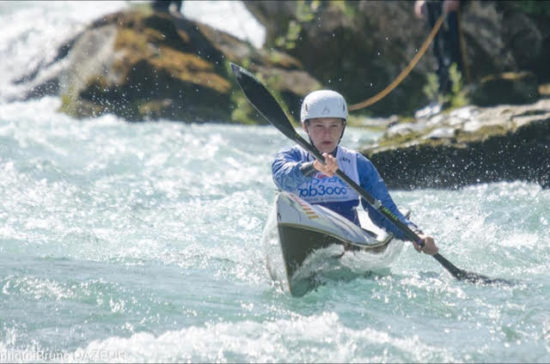
Aleissa lives near mountain rivers. When paddling surfski, she paddles the Epic V12.
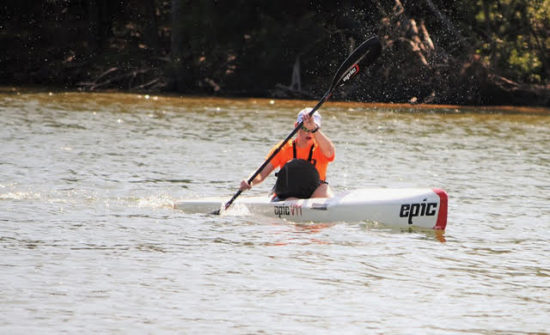
Since I am fairly new to surf ski for that long, I love any conditions I can get! Give me glassy flat water, or windy chop and I am excited! I am trying to build experience on downwind paddles, and this is the most exciting for me right now. In my wildwaterboat, I love technical rapids. Since I learned to paddle in the Southeast, I love lower volume rock-dodging to high volume holes and waves.
What I love about paddling is the ability to be in a natural setting, and see it from a view that people normally don’t see it from. While some wildwater sprint races take place on artificial courses, my favorite courses are on natural rivers. I have done most of my paddling around Western North Carolina, and I think it is one of the best places to paddle in the world. We have whitewater, flatwater, lakes and rivers! I particularly love the Pigeon River for wildwater, and the Nolichucky River is beautiful for any type of whitewater boating. If I could paddle anywhere in the world, I would definitely pick the Soca Valley for wildwater, and I hope to work up to being about to do the Doctor race in Australia for surfski.
I started paddling for fun with my dad on Long Island. We lived by a tidal river and in high school I used to go out paddling with my friend, Wesley, on the weekends. For my sixteenth birthday, I asked for a kayak instead of a party, and the rest was history! When I went to college, I tried roll practice in the pool, and then got invited to a river session, and from there I was hooked on learning.
I started paddling surf ski for a few different reasons. First, I realized that I love long distance races! Most surf ski races are longer than 9k. Second, my partner and I went to SC for a weekend and had the opportunity to take out an Epic V8 double. We regularly refer to that day as the most fun we have ever had paddling. What I love about surf skiing is the strong community of women. In wildwater, there are very few women and most of them participate recreationally. When I came into the surf ski community, there was a strong community of female surf ski athletes that train year round! It is fun to mix up the races and work off each other to be better and better.
Wildwater is exciting due to the constant and changing nature of the courses. A single river changes drastically when the water level changes. There are also rapids to navigate, all while traveling at race pace! It is fun to feel like you are flying down a course, at your maximum effort! I feel a lot of this same excitement surf skiing in moving water. When you are trying to catch a wave or link waves, you are adapting your pace and cadence to soar down the face! However, I love the grind of surf ski races as well. Many of surfski races happen on flatwater and I love burying my head and simply taking races one hard pull at a time.
A funny thing I have had to get used to in the surf ski is the pedals you use to steer the boat. In a wildwater boat, you have no rudder, a fixed foot bar, and you steer the boat through body position and sweep strokes. In a surf-ski, you push through the ball of your foot to adjust the rudder. This has caused more than one mishap for me, when I am tired and forget that I am in a surfski. I drive through the ball of my foot and this turns my rudder almost ninety degrees in a direction! I have almost fallen in too many times to count!
Salli O’Donnell, Ultramarathon paddler
Salli O’Donnell is an ultramarathon paddler. Ultramarathons take the paddlers over varied waterways for hundreds of miles and several days. In a sea kayak, she has completed the 2012, 2013, 2014 WaterTribe North Carolina Challenge (90+ miles), 2013, 2014, 2015 WaterTribe Everglades Challenge (300 miles), 2016 Florida Winter Nationals (67 miles), and the 2018 Yukon 1000 (1000 miles). In 2015, Salli started using surfskis for most of her ultramarathon races and has completed several 100+ miles events including the 2015 James River Rundown (100 miles), the 2016 James River Challenge (140 miles), the 2017 Missouri River (340 miles) and the 2019 Texas Water Safari (260 miles).
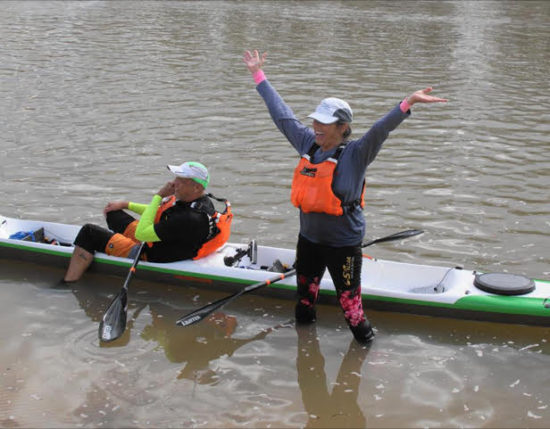
Salli currently lives near the Gulf of Mexico. When paddling surfski, she paddles Epic V8 Pro, Stellar S18S and a Findeisen UX.
I’ve always loved the water. I was a swimmer, scuba diver, water skier, beach lifeguard, you name it, until the reality of adulthood hit and my “beach bum” lifestyle existed only in my mind. For the next three decades, running became my energy outlet and spirit lifter. I could easily run anywhere no matter where life, work and responsibilities took me. Unfortunately, a knee replacement in 2010 forced me to limit my running. In 2012, knowing I loved endurance running and needing to find a replacement activity, my husband Mike searched other endurance sports to find something that would suffice; he found the WaterTribe. At that time this group hosted events for paddlers and sailors to race around the open waters of coastal North Carolina and Florida. The only thing I ever paddled at that time was an Ocean Kayak Venus, a 10 foot roto-mold sit-on-top kayak that I thought would be perfect for the 90-mile North Carolina Challenge. Since the WaterTribe races are expedition style and unsupported races, Mike convinced me that a sea kayak might be a more wise choice! I ended up with an Eddyline S18 Falcon that safely carried me through many, many training and racing miles.
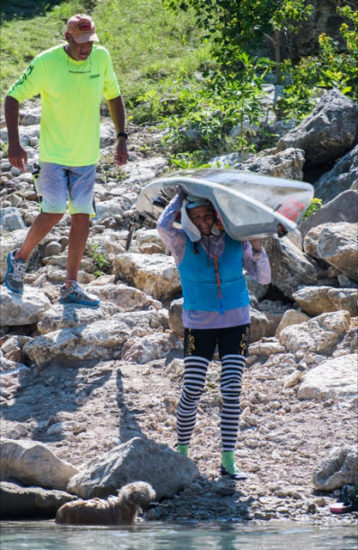
In 2014, I switched to a Stellar S18R which was a lighter, faster, lower volume sea kayak. I got familiar with this sleek vessel that summer in Michigan at the Ladies of the Lake Paddle Sports Festival, a fun gathering of paddling gals. I first raced her in the WaterTribe’s 2014 North Carolina Challenge and then in their 2015 Everglades Challenge. I loved how she slid through the water but her racing days were numbered.
In the winter of 2015, Mike discovered surfskis and bought a couple of used ones for us to try. Mine was an old Findeisen UX, tippy as heck, but I loved it! Knowing that I could go no further than a few 100 paddle strokes on flat water without flipping, we decided to get a couple of stable Epic V7 surfskis to jump into racing. Within a week of receipt, I was racing her in a 100-mile event down the James River, a gorgeous waterway in Virginia. I was hooked on surfskis!
One of my struggles with endurance paddling is how to balance proper hydration with the unavoidable (pun not intended) reality of “peeing”. My tendency was to limit my fluid intake so that my fluid output would also be limited…not a good plan! For a woman in a sea kayak, I have the only acceptable options of either finding a place to get out or some variation of “going” in a sponge/container – both options are time consuming and the latter is troublesome and often messy. In a surfski there is no such concern; with a few swishes of the hips to bring water into my ski and an open bailer, I am good to “go” (pun intended!). But that is not the only aspect I prefer when comparing sea kayaking to surfskiing. I am more daring and adventurous in my surfskis mainly because I never perfected the second half of my sea kayak roll but I can remount even the tippiest of my surskis with ease. On the other hand, my sea kayak has allowed me to paddle year round while living in Virginia. There is little that can compare to the peace, beauty and tranquility of being all by myself, buttoned up in a sea kayak, breaking through a crisp layer of surface ice while viewing pristine landscapes of virgin snow.
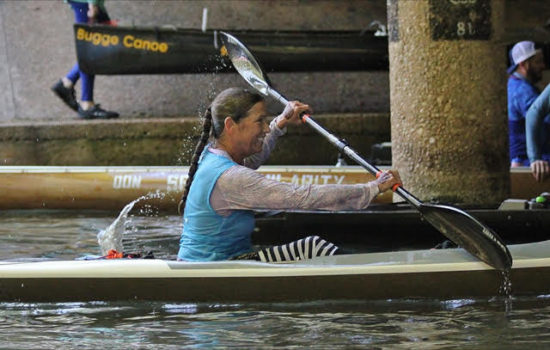
Whether in a sea kayak or a surfski, my most favorite times to paddle are in the dark of night when I’m all by myself. Even as I type this I question myself, but quickly affirm this is true. I’ve been in a sea kayak in the middle of the Everglade’s Wilderness Waterway a wee bit after midnight running without any lights and had my adrenaline surging as tarpon (at least I hope that was what they were!) rolled all around me. When I turned on my headlamp to find the cut to The Nightmare, a narrow and twisty waterway, all I saw were hundreds of the ruby eyes of alligators along the banks quietly watching me slip by. What a thrill and an experience!! A comparable memory came from a ride on one of my surfskis during a race down the Missouri River. I was all by myself, the sun had set, all was dark and I began seeing campfires in the trees along the river’s bank. Finally, a grand turn in the river revealed the rising of a blood-orange full harvest moon – absolutely stunning! Whether frightening or beautifully tranquil, the solitude and peace of paddling at night are my siren’s songs.
So, now I’ve moved back down to the panhandle of Florida. I grew up 90 miles north in the 60’s and 70’s never realizing that these are the most beautiful waters and beaches in the world. The choices of paddling venues include twisty creeks, sheltered bays and lagoons, wide sounds that go from flat water to wonky waves at the drop of a hat, fast rivers, and the open gulf. How could a paddler ever get bored? Although I mainly race in surfskis these days, I still love playing in my different kayaks. My little plastic Juanatica Victoria is perfect for exploring the numerous little creeks, the Dagger Chaos makes surfing a blast, and although I no longer need my sea kayak for winter training, she has been repurposed for kayak sailing.
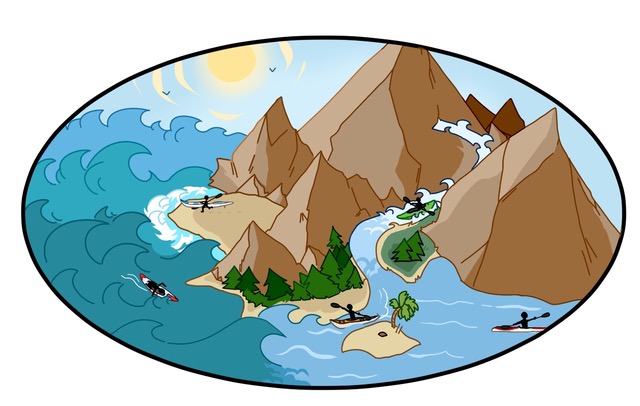
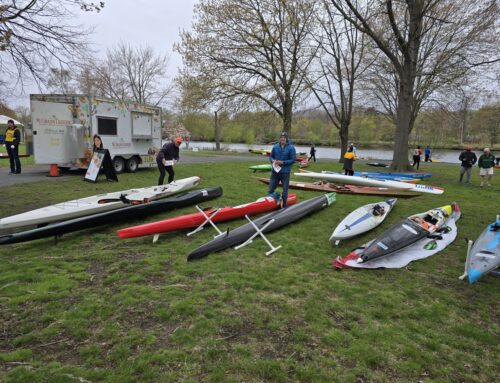
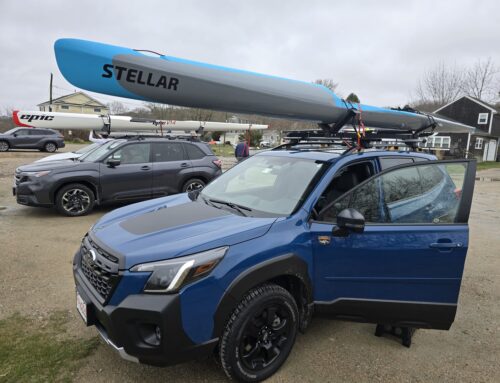
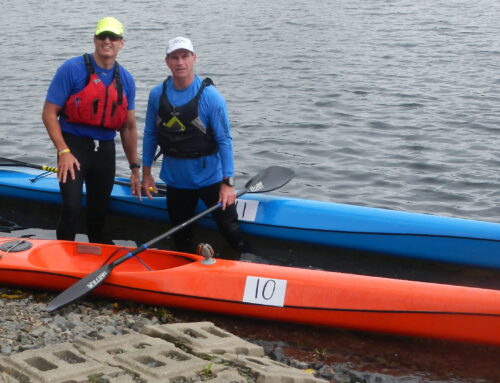
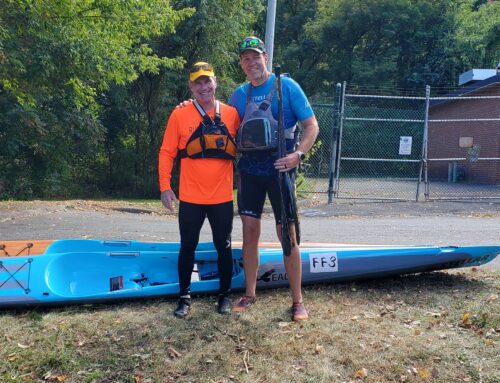
Leave A Comment
You must be logged in to post a comment.